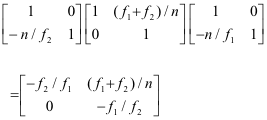
 | Telescope, a two-lenses system, can be either refracting ( the objective is a lens) or reflecting ( the objective is a mirror). It is formed by eyepieces lens and objective lens and the lenses are separated by a distance equal to the sum of their focal lengths. |


(FIGURE 1) Rays paths in a astronomical telescope system: the length of the telescope, L, becomes sum of the focal lengths, L= f1 + f2.
This can be done through the ray tracing using the transfer matrix so the system matrix becomes:

The ray-transfer from a plane at a distance d in front of the objective lens, to a plane at a distance d behind the eyepiece lens, is now given by the transfer matrix:

Then the matrix reduces to

where  =y’ y is the magnification (where y’ is the image height and y is the object height). But, in contrast to other imaging systems, we now have the same magnification:
=y’ y is the magnification (where y’ is the image height and y is the object height). But, in contrast to other imaging systems, we now have the same magnification:

In order to collect as much light as possible from a distant object, the objective should be as large as possible. However, in order to have large lenses manufactured, there are obvious problems. For example, it is essential to have the same optical properties throughout the lenses. Otherwise, any internal bubbles will alter the refractive index in those regions. Furthermore, lenses such as achromatic lenses tend to suffer from a residual amount of chromatic aberration (ie. optically dispersive). To overcome these difficulties is to build a telescope using parabolic mirror by the Newtonian design. However, most of the world largest telescopes nowadays employ the Cassegrain design. The advantage of this design is the beam-spreading qualities of the secondary mirror, which means that the effective focal length is several times that of the primary mirror. This allows for relatively more compact, easily-engineered, cost efficient and larger telescopes compared to telescopes engineered with Newtonian Design.